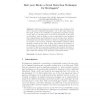Free Online Productivity Tools
i2Speak
i2Symbol
i2OCR
iTex2Img
iWeb2Print
iWeb2Shot
i2Type
iPdf2Split
iPdf2Merge
i2Bopomofo
i2Arabic
i2Style
i2Image
i2PDF
iLatex2Rtf
Sci2ools
RAID
2010
Springer
2010
Springer
Bait Your Hook: A Novel Detection Technique for Keyloggers
Software keyloggers are a fast growing class of malware often used to harvest confidential information. One of the main reasons for this rapid growth is the possibility for unprivileged programs running in user space to eavesdrop and record all the keystrokes of the users of the system. Such an ability to run in unprivileged mode facilitates their implementation and distribution, but, at the same time, allows to understand and model their behavior in detail. Leveraging this property, we propose a new detection technique that simulates carefully crafted keystroke sequences (the bait) in input and observes the behavior of the keylogger in output to univocally identify it among all the running processes. We have prototyped and evaluated this technique with some of the most common free keyloggers. Experimental results are encouraging and confirm the viability of our approach in practical scenarios.
| Added | 30 Jan 2011 |
| Updated | 30 Jan 2011 |
| Type | Journal |
| Year | 2010 |
| Where | RAID |
| Authors | Stefano Ortolani, Cristiano Giuffrida, Bruno Crispo |
Comments (0)

